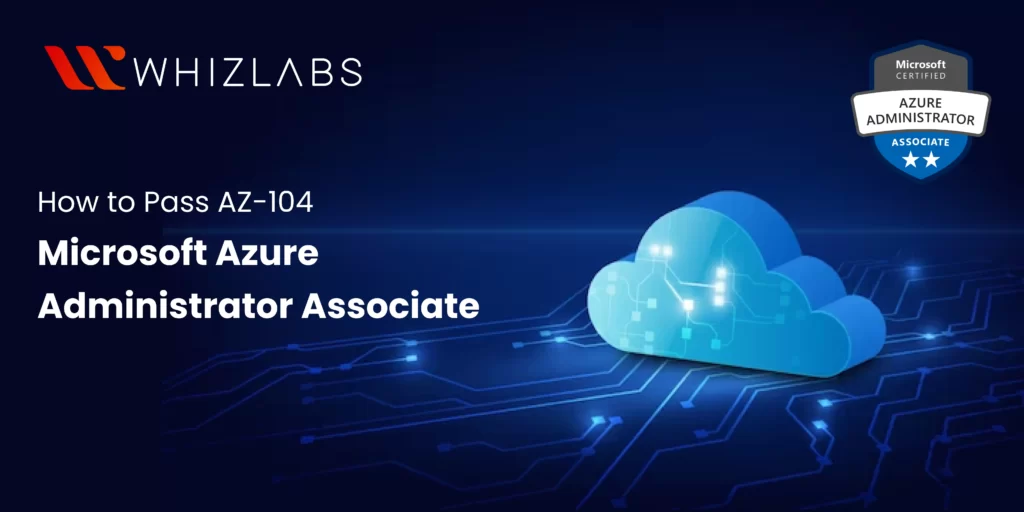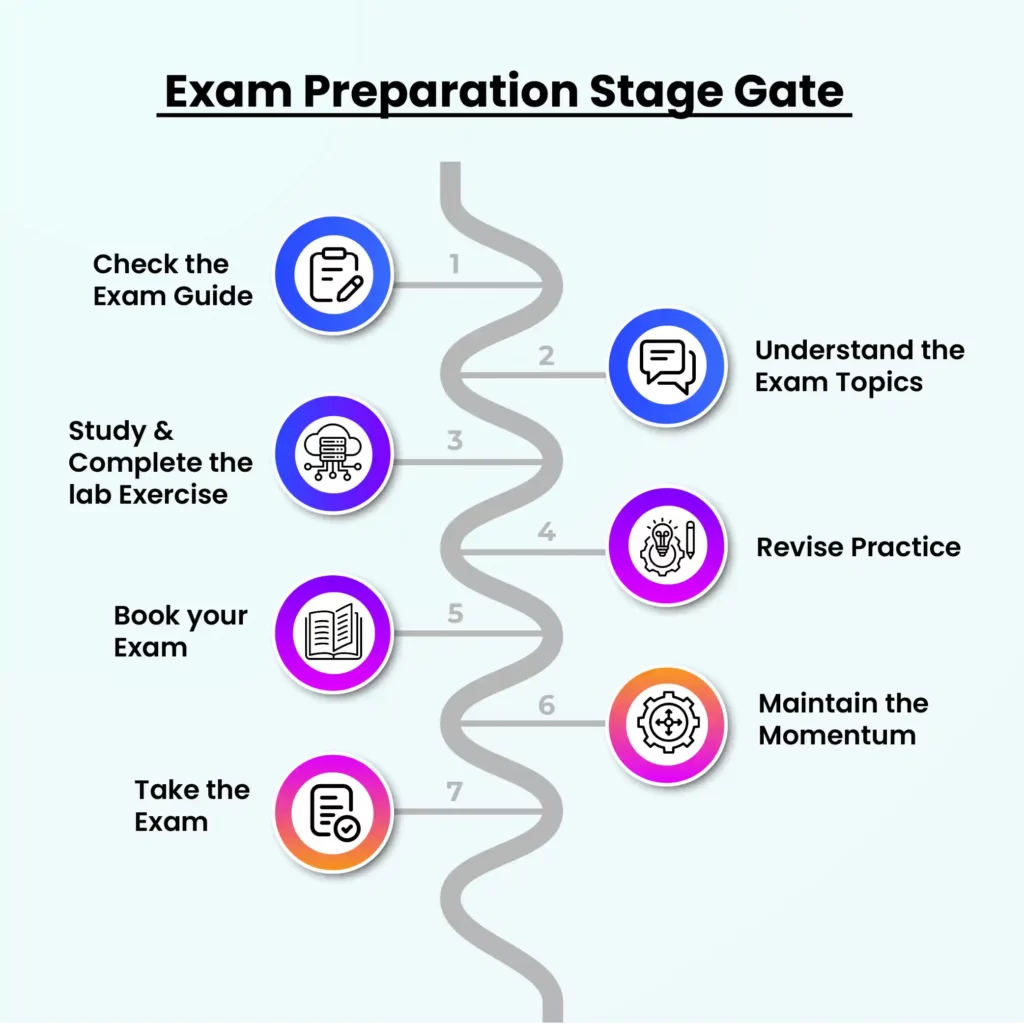As the second-largest cloud provider after Amazon AWS, Azure certifications are among the most sought-after certifications. Such certifications not only validate your skills and knowledge but also help you to advance your career. Designed for Azure administrators, AZ-104: Microsoft Azure Administrator Associate is an intermediate exam for developers. It is tailored for professionals responsible for implementing an organization’s cloud infrastructure and coordinating with other roles to deliver Azure networking, security, database, application development, and DevOps solutions.
This blog discusses the proven techniques that can help you learn how to pass the AZ-104: Microsoft Azure Administrator Associate exam on your first attempt. Clearing an exam like this one on the first attempt is crucial in many ways—it saves time in AZ-104 exam preparation, helps you quickly leverage the certificate for career advancement, and boosts confidence and mastery.
Exam Stage Gates on How to Pass AZ-104: Microsoft Azure Administrator Associate
StageGate is a technique used in product development where the entire project is divided into distinct sequential stages, each representing a key milestone. Applying the same concept, we will break down the exam process into seven manageable phases with specific goals and checkpoints. These stages will ensure that you’re focused, well-prepared, and ready to pass the AZ-104 certification on your first attempt. By following this structured approach to AZ-104 exam preparation, you can reduce stress leading up to the exam day and take the exam with an uncluttered mind.
Stage gate 1: Check the exam guide
Your first step towards preparing for this exam is reviewing the AZ-104 exam guide thoroughly. A clear understanding of the guide ensures your preparation is aligned with the exam goals and structure, avoiding last-minute cramming and paving the path to success. Microsoft provides a comprehensive exam guide for AZ-104: Microsoft Azure Administrator Associate. When reviewing the guide, make a note of several important points:
- Exam overview: find the goal and audience of the exam
- Skills measured: check the domain and the percentage dedicated to each domain in the exam
- Exam prerequisites: ensure you have the required prerequisites
- Study resources: identify the Microsoft-provided learning resources
- Others: note additional information such as exam policies and updates, question patterns, registration details, and so on
The AZ-104: Microsoft Azure Administrator Associate certification does not require formal prerequisites. However, Microsoft recommends at least six months of hands-on experience administering Azure, along with a solid understanding of Azure cloud services. If you’re already familiar with Azure and cloud computing concepts, you can directly take the AZ-104 certification. If you are new to Azure, consider taking AZ-900 Certification to build your foundational knowledge.
Stage gate 2: Create a study plan
After you’ve thoroughly checked the exam scope and the five domains in the guide, develop a concrete AZ-104 study plan. Create a timeline by setting the exam date first, which will help you avoid any procrastination or loss of momentum during preparation. Once you know how much time you’ve until the exam, you can break down your study plan into manageable chunks covering all exam topics adequately. The preparation duration for the exam varies from person to person, based on their prior knowledge/experience and learning style. However, here are some rough estimates to get you started:
Next, create a step-by-step AZ-104 study plan based on your comfort level of the exam topics. Here’s an example of a 3-month study plan, with daily two-hour study sessions. This example shows the plan only for the first 1-2 weeks:
Day 1-4
Manage Azure identities and governance
- Overview of Microsoft Entra users and groups
- How to Manage access to Azure resources
- Need to know how to manage Azure subscriptions $ governance
Day 5-8
Implement and manage storage
- Configuring access to Azure Storage Services
- Configuring and managing storage accounts
- Configuring Azure Files and Azure Blob Storage
Day 9-12
Deploy and manage Azure compute resources
- Automate deployment of resources by using ARM templates/Bicep files
- Create and configure Azure virtual machines
- Provision and manage containers in the Azure portal
- Create and configure an Azure App Service
Day 12-14
Implement and manage virtual networking
- Configuring and managing Azure virtual networks
- Configuring secure access to Azure virtual networks
- Configuring Azure DNS and Azure load balancing
Day 15-16
Monitor and maintain Azure resources
- Monitoring Azure resources
- Implementing Azure Backup and Azure Recovery Services Vault
Day 17-18:
- Get hands dirty by doing hands-on activities and sandbox environments
Day 19-20:
- Practice yourself to get more ideas about the Microsoft Exam Formats
Stage gate 3: Study and complete lab exercises
During your study phase, you can leverage the learning resources available in Azure Documentation and the resources provided in the AZ-104 exam guide. For each exam topic, go through the corresponding technical documentation. Bookmark the important pages and key sections and make notes, preferably digital notes. You can revisit the bookmarks and notes quickly during revision. In addition, take help from learning providers such as Whizlabs, or study groups and online forums.
Lab exercises: While Azure documentation provides the theoretical foundation, doing lab exercises will help you apply the concepts practically. This exam includes scenario-based and performance-based questions that require you to know how Azure services interact.
You can leverage the following Whizlabs resources to deploy and configure different Azure services and understand how they interact.
- Exam cheatsheet: It acts as a quick reference guide for Azure topics, services, and CLI commands covered in the AZ-104 exam.
- Video lectures and practice exams: It covers 100+ video lectures, 200+ high-practice test questions with detailed explanations, and 90+ Azure hands-on labs to gain practical experience and develop your skills firsthand.
- Practice Labs: It offers hands-on labs specifically tailored for AZ-104 exam success. These labs simulate the real-world Microsoft Azure Exam [AZ-104] Certification Exam – (New 2024) in a guided environment, helping you build the necessary skills.
- Sandbox Access: It provides a controlled environment where you can perform the labs without incurring costs on your Azure account.
For productive learning, create an ideal study space around you, stick to a timetable, and study daily at the same time to build a routine. To track your progress, maintain a study log and review it at the end of the week to assess what you can achieve and what needs more attention.
Stage gate 4: Revise practice
Revision ensures you are well-prepared and increases your chances of clearing the exam in the first attempt. Before revising, assess your preparation level to identify areas that need more practice by completing these tasks:
- Review exam topics and goals
- Compare the completeness of the study plan against exam goals
- Check past performance to identify patterns in mistake
- Revisit your past bookmarked pages/sections and notes
After you’ve identified your key areas, you can create a structured revision plan similar to your study plan, covering both theoretical concepts and practical applications using the lab. The revision plan is a targeted review to consolidate knowledge, reinforce understanding, and prepare you for the exam. In contrast, the study plan is focused on building foundational knowledge of new material covering a broad range.
Stage gate 5: Book your exam
After thorough revision, you will be more confident in taking the exam. Booking your exam early will help you secure a preferred slot that aligns with your deadline.
Consider these points while booking:
- Select the correct certification
- Decide whether you want to take the exam at a physical center or online
- Check the reschedule and cancellation policies
- Identification requirements
The exam time can influence your performance because our cognitive capabilities such as memory, attention, and problem-solving skills can peak at different times of the day. Select a time when you feel most alert and focused. If you’re a morning person, select an early morning slot; if you perform better in the afternoon, select a later time. If you take the exam at a center, check the travel time and traffic patterns to reach on time so that you can settle in before the exam starts. If you take the exam from home, check the technical requirements and exam safety measures, and ensure you’ve a conducive environment at home.
Stage gate 6: Keep the momentum
After booking the exam, don’t let your focus shift from our study plans. Maintain the momentum of your preparation with practice mock tests to get used to managing your time effectively under exam conditions. This is the time to mimic the exam environment as much as possible. Revisit the Whizlabs resources (cheat sheet, video lectures, hands-on labs, and sandboxes) listed in Stage gate 3: Study and complete lab exercises. In addition, you can explore the exam sandbox and the practice assessment listed in the Azure official portal.
Stage gate 7: Take the exam
Now you’ve come to the last stage of taking the exam. This is the time to revisit the exam-related details that you’ve noted in Stage 1: Check the exam guide. Here’s a recap:
- Time duration: you have 120 mins to complete the exam.
- Number of questions: the number might vary; usually it’s around 40-60 questions.
- Passing score: you must score a minimum of 700 out of 1000; marks for individual questions are not given and there’s no negative marking.
- Question types: Microsoft doesn’t specify exam formats or question types before the exam. However, in general, the exam includes a mix of multiple-choice, drag-and-drop, scenario-based, and performance-based (lab) questions.
For more information, visit Question types on exams.
Typically, case studies and performance-based tasks take longer time than general questions such as multiple choice or drag and drop.
- Case studies (if included): mimic real-life scenarios and check your ability to apply knowledge to actual situations. Each case study can have multiple questions (4-6), and the time taken to complete them can vary.
- Performance-based tasks: test your ability to perform actual administrative tasks in Azure, which can include configuring, managing, and troubleshooting various Azure services.
If you’ve prepared well, 120 mins is good enough to attempt all questions. Track your time to ensure you can pace with the given time, and you are not rushing through your questions. If you find spending too much on a question, select an answer to the best of your ability, mark it for review, and move on. Another good practice is to create a mental time allocation strategy to use time effectively without getting stuck in one section. Here’s an exam time allocation strategy.
Review and reflect on your next steps
With a comprehensive coverage of core Azure services, AZ-104: Microsoft Azure Administrator Associate is a crucial cloud certification, opening up new career opportunities in cloud administration and beyond. By following the stage-gate-like strategy given in this blog, you have a higher chance of passing this exam on your first try. This certificate also provides a strong foundation for pursuing more advanced Azure certifications, such as the AZ-305: Azure Solutions Architect Expert, AZ-400: DevOps Engineer Expert, and AZ-120: Microsoft Azure SAP Workloads —making it a key part of the continuous learning and certification journey. Whizlabs can significantly ease your journey with a plethora of resources: video courses and tutorials, hands-on labs, practice tests, and others.
- Mitigating DDoS Attacks on AWS with Security Specialty Certification Knowledge - October 17, 2024
- How to Connect AWS Lambda to Amazon Kinesis Data Stream? - October 3, 2024
- Deploying and Optimizing Machine Learning Models on AWS - September 3, 2024
- How to Pass AZ-104: Microsoft Azure Administrator Associate on Your First Attempt - August 29, 2024




